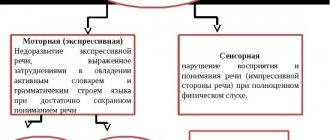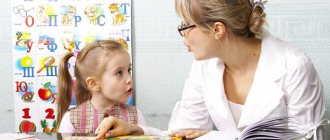Representation of a teacher-psychologist for a pupil of a preschool educational institution
F.I. child:
Date of birth: Age at the time of examination: 5 years 2 months.
Preschool institution: senior group No.
1. Appearance and behavior in the examination situation: neat appearance, easily and quickly comes into contact with adults, is sociable, answers questions willingly; understands an adult’s instructions only after repeated repetition, shows interest in completing tasks, but the interest is not persistent and quickly passes.
2. Pace of work and performance: gets into work quickly, the pace of work is moderate, switchability is not difficult. During class, he is often distracted even in the absence of external stimuli.
3. General awareness of the child (social and everyday orientation): knows his last name, first name, age, family composition, calls family members by name. Temporal and spatial ideas and ideas about the environment are not sufficiently formed.
4. Features of lateralization: the leading hand is right.
5. Characteristics of motor skills, incl. graphic activity: the level of development of fine motor skills does not correspond to the age norm; there is a low level of graphic activity and hand-eye coordination.
6. Features of memory: the volume of visual memory corresponds to age, easily and quickly remembers visual material, reproduction is not difficult; the level of development of voluntary verbal memory is reduced compared to the age norm, the volume of auditory-verbal memory is insufficient.
7. Peculiarities of perception: the idea of the color, shape, size of the object is formed, visual synthesis and holistic perception of the object is not sufficiently formed. The level of spatial perception is low.
8. Features of attention: attention is unfocused, unstable, increased distractibility is detected, the overall level of voluntary attention is reduced compared to the age norm.
9. Features of thinking: generalization and classification skills are not sufficiently developed; when comparing and generalizing, one does not independently identify an essential feature. The level of development of analytical and synthetic activities is low. Does not independently establish cause-and-effect relationships and dependencies in a visual and verbal situation.
10. Features of speech development: the active vocabulary is insufficient, there are violations of sound pronunciation and grammatical structure of speech.
11. Features of the emotional-personal sphere: there is increased excitability, liveliness, haste, impulsiveness, restlessness; The prevailing mood is cheerful.
12. Features of the motivational-volitional sphere: self-regulation and control are low due to low concentration of attention, the organizing help of an adult is effective.
13. The nature of interpersonal relationships: active, sociable, mostly plays in a group of peers, strives for emotional contact with peers and adults. Shows initiative in games and in classes. The activity of verbal communication corresponds to the age norm.
Conclusion of the educational psychologist: the level of development of mental processes is below the age norm. Features of mental activity, low concentration of attention, immaturity of fine motor skills and immaturity of self-regulation and behavior control come to the fore.
Recommendations: development of thinking operations, voluntary attention and voluntary regulation of activity, correction of impulsivity.
Date: "__" _____________ 20__
_________________________________(signature of a specialist)
Share -
Tags - documentation for psychologists Sample Forms
View more
Characteristics of a kindergarten student for PMPK
Information about parents:
Mother:
Place of work:
Education:
Father:
The child has been attending kindergarten since November 17, 2007. He came to the second junior group from the nursery group. I quickly got used to the new environment, because... I knew all the children. The boy attends kindergarten almost constantly and rarely gets sick. Relations with children are rather friendly, although there are often conflicts over toys. If a child likes a toy, or it is similar to toys that are in his home, then the child may mistakenly take it for his own and it is difficult to convince him otherwise. He gets offended by comments, turns away, may cry, and retires.
In the familiar setting of a kindergarten, the child independently follows the familiar rules of communication with adults and children. He almost always enters a group in a good mood: he says hello, says goodbye, asks for help in separate words, often pronouncing words incorrectly.
Speech development . Vocabulary is poor. A child’s speech consists of individual words, often incomprehensible to adults and children. The pupil rarely constructs sentences of three or four words, using only those words that he often uses: “I want to eat”, “My toy”. To achieve the desired result, teachers often have to repeat memorized words with the child; when repeating, the boy rearranges the sounds.
The child does not participate in the conversation, trying to turn away from the children. He cannot compose a story based on a plot picture, a set of pictures, retell short works, or compose a story based on a picture - he only names individual words, sometimes not even related to each other.
He has a very difficult time remembering poetry, cannot determine the place of a sound in a word, and sometimes does not understand what is being asked of him. To learn a couple of lines of a poem with a child, you need to put in a lot of effort, sometimes more than one day. When reading works, fairy tales, poems, nursery rhymes, the boy is distracted by foreign objects and often covers his ears with his hands, and at the very beginning of reading the work. When you ask him: “Why are you doing this?” answers “I’m tired, I want to play” knows that he is a boy, but at the same time speaks of himself in the feminine gender.
Mathematical representation . The child’s ordinal counting is within 10, he counts in forward order, but thinks for a long time in reverse (counts from the beginning and stops at the number that needs to be named). Counts items from a large quantity according to a pattern given by a number. When counting objects: distributes the figures on the table as they are located on the card (visually copying them, as shown in the sample). Places objects of various sizes in ascending and descending order, sometimes gets confused, notices mistakes and corrects them himself, asks the teacher (“Is that correct?”). Knows geometric shapes, but does not always name them correctly.
Does not define or express in words the location of the object to itself or other objects. The student does not know how to navigate on a sheet of paper, lining up all the geometric shapes in a line from top to bottom. Confuses the left and right sides, does not name the current day of the week, confuses the changing parts of the day, seasons. Knows primary colors, confuses white with brown, does not know shades.
Visual activity. The student shows interest in works of art and responds emotionally to beautiful things. He draws and sculpts on his own. Holds the brush and pencil correctly. When drawing the outline of an object with a simple pencil, he cannot control the pressure on the pencil, leaving rough lines. When working individually with a boy, the boy uses a variety of techniques in brush painting.
He does not know how to develop a plot in a drawing, depicting it in separate fragments, and often duplicates them.
Does not correlate objects and their parts by size, height, or location relative to each other.
Conveys in the image the basic properties of objects (shape, size), sometimes confuses the color, replacing it with another. Visually transfers images into drawings (copying - sketching). Upon completion of work, tidies up the workplace. For a long time he draws what he likes best (Spiderman, tank, etc.). Uses a variety of cutting techniques, but does not do it carefully. Doesn't always bring a plan to completion.
Uses plasticine, sculpts objects of different shapes, using learned techniques and methods. Doesn't always convey the proportions and poses of the figures.
Constructive activity. Plans to create his own building, creates buildings according to a drawing, according to a model, according to a diagram. The boy loves to use building material. The boy finds new constructive solutions and is happy when he is praised. It is not always possible for a child to work collectively: he takes the construction kit parts from the children, trying to independently create his own building. He is offended if they offer to combine his building with other children. May become stubborn and not take part in the future.
Game activity. The child’s favorite games: puzzles, construction sets, likes to draw and color. Willingly plays outdoor and didactic games, but does not always follow the rules of the game and turn. He is happy when he is put in leading roles, but does not always obey the rules in games, sometimes does not understand what is required of him: he is offended, and does not know how to negotiate with a partner. Rarely plays role-playing games with children and does not know how to coordinate his actions with the actions of his partners.
Fulfills the request of his elders and rejoices when he is praised. Shows him his favorite toys and books. Shows empathy towards adults and children.
Uses toys for their intended purpose. Treats his toys with care, neatly folds them and puts them in their places. He notices broken toys and brings them to an adult: “The toy is broken.” Plays the game he likes for a long time. He can put the toy he likes in his cubicle.
Physical development. Performs basic movements correctly. The child's coordination is not impaired. The boy eagerly turns on and masters new and varied movements. Actively and interestedly participates in outdoor games. Doesn't always keep up with the overall pace. When changing lanes, he gets confused and his sense of rhythm is disturbed.
Musical activity . Does not show interest in musical works, is often distracted, and interferes with children. Does not show independence in using songs, but if songs are often sung (in preparation for matinees) he sings.
The child is independent in self-care , knows how to use cutlery, quickly dresses and undresses, brushes his teeth independently, notices problems in his appearance, but does not always keep his closet in order (he throws things around, does not turn them inside out), folds his things when reminded, and is often stubborn .
For the full text of the material Characteristics of a kindergarten student for PMPK, see the downloadable file
. The page contains a fragment.
| Author: Stupnikova Tatyana Aleksandrovna → Publisher 09/18/2015 0 272391 8575 | Comment |
Thank you for your mark. If you want your name to be known to the author, log in to the site as a user and click Thank you again. Your name will appear on this page.
Login | Registration
Have an opinion? Leave a comment
Sample characteristics on the PMPK for a 1st grade student with mental retardation
Psychological and pedagogical characteristics of the student
1 "A" class
_________________schools
Full name, date of birth, living at address: ___________
___________ entered grade 1 “A” ____ school in September 20__, did not attend kindergarten before entering school. Studied at the educational educational complex “School of Russia”. To study at school _____________
was not ready (delayed speech development, underdevelopment of mental processes, fine motor skills of the hands were not developed). The development of gross motor skills corresponds to age: walks, runs, jumps, cares for himself. The appearance is neat.
_________ is brought up in a complete family and is the eldest child. He has a younger sister. A child is welcome in the family and loved by all family members. ___________ is given a lot of attention, he is surrounded by love and constant care from his parents and grandmother.
For a number of objective reasons, in the first half of the 2019-2020 academic year, Yura attended school for a short time.
In literacy and writing lessons, _________- experiences difficulties in orienting in notebooks, cannot remember the graphical spelling of individual letters and their connections, perform sound-letter analysis of words, or draw up diagrams for them. The skill of syllabic reading is poorly developed. ___ pronounces individual sounds, tries to combine them into syllables and words, but he succeeds with great difficulty, comprehension of what he read occurs slowly, the student cannot understand the meaning of the spoken words and sentences, or convey the content. The student’s vocabulary is limited to everyday vocabulary, he speaks in phrases or individual words, the grammatical structure of speech and sound pronunciation are impaired.
In mathematics lessons he has difficulty writing numbers; ____ has not developed basic computational skills: he cannot add and subtract within the first ten. The student gets confused in the names of geometric figures, segments and broken lines.
When performing any task, only step-by-step actions are available to him strictly under the guidance of the teacher. ____ cannot concentrate on work for a long time, plan his activities, find and correct errors in his work. It is difficult for him to express his judgment and draw simple logical conclusions. During lessons, he completes assignments very slowly and does not keep up with the pace of the class. During classes, he is often distracted by any external stimuli, and when it comes to everyday issues (games, toys), he shows active participation and interest.
The boy is kind, calm, shy, afraid to be left without his mother and therefore often cries and asks to go home. It is difficult for him to settle into a team, find friends and communicate with peers. In the class, the guys treat him with understanding, help and feel sorry for him.
For the purpose of providing information on _ January 20__. The school psychologist ___________ conducted an examination of the student at the request of the class teacher ________., which showed that ____________ is characterized by decreased mood tone, moodiness, and tearfulness. The student is not focused on cognitive activity, the level of training is low, does not correspond to his age, and it takes time to get involved in work.
Poorly developed fine motor skills
hands
The pace of activity
is low.
The child has increased fatigue and is often distracted. Short-term and long-term memory
does not correspond to age norms.
The student’s attention
is involuntary, distracted, short-lived: it takes a lot of time to master even small material.
Generalization operations
are not possible, because sometimes it is difficult to attract his attention and achieve the desired answer. Completing small tasks is possible only with the constant organizing and accompanying help of adults.
Thinking Research
and
speech
showed that _____________ is not capable of identifying cause and effect relationships, analysis and synthesis, identifying commonalities and differences, grouping objects.
He cannot establish a logical sequence in a series of plot pictures on his own. According to the test results, self-esteem
is inflated.
Poor development of learning skills and peculiar behavior require individual correction. It is recommended to undergo additional examination by PMPC specialists to make a decision on the child’s further educational route.
Teacher-psychologist_______________
Classroom teacher___________
Head teacher________________
Date of:
Algorithm for compiling characteristics for GMPK for children 4-7 years old + submission form
Reason for referral to GPMPK
: at the request of parents, clarification of the educational route, determination of the education and training program for preschoolers with developmental disabilities, transfer to another educational institution.
1.
In the
“General information about the child”
, you should indicate where he came from (from a family, from another MBDOU), whether there were long breaks in attending a preschool institution, and for what reasons.
Assessment of the child’s adaptation in the group: good; satisfactory; insufficient; bad; other.
2.
In the
“Family characteristics”
, you must provide information about your parents. Fill out the subsections:
Family composition
: complete, incomplete, having many children, presence of brothers and sisters.
Family type
: a) prosperous (parents are morally stable, master the culture of education); b) dysfunctional (pedagogically incompetent: there is no unity of parents’ demands, the child is neglected, he is mistreated, systematically punished, poorly informed about his interests and behavior in kindergarten); c) a morally dysfunctional family (parents lead an immoral lifestyle, drunkenness, parasitism, have a criminal record, and are not involved in raising children); d) conflict family (there is a dysfunctional emotional atmosphere in the family, conflicts, parents are irritable, cruel, intolerant).
Who is raising the child?
: mother, father, grandmother, others
The nature of the relationship between parents and child:
a) family dictatorship (systematic suppression of the child’s initiative and self-esteem); b) excessive care (satisfying all the child’s needs, protecting him from difficulties, worries, efforts); c) connivance (avoidance from active participation in the child’s upbringing, passivity, recognition of the child’s complete autonomy) d) cooperation (attitude of mutual respect, joint experience of joy and grief).
3
.
In the section “ Features of the child’s appearance”
, briefly note: the neatness of clothing, whether the parents monitor the child’s appearance, posture, gait, gestures, facial expressions, the presence of drooling, etc.
4.
In the “
Somatic health”
, indicate the health group; how often does he get sick and what diseases; appetite, characteristics of daytime sleep; whether the child suffers from enuresis and (or) encopresis, etc.
5
.
In the section “ Features of the motor sphere”
General motor skills
: normal, slightly impaired coordination, pace, rhythm of movement, motor awkwardness.
Manual motor skills
: normal (preserved function), lack of fine motor skills, motor limitation, range of movements (full, incomplete, strictly limited), pace (normal, fast, slow), switchability (accurate, inaccurate), coordination (normal, minor violations, impaired, incomplete).
Leading hand
: left-handed, ambidextrous, right-handed.
6
.
In the section “ Characteristics of the child’s cognitive sphere”
give
characteristics of mental processes:
Characteristics of attention
: during classes cannot be attentive and concentrate on something for a long time; constantly distracted; able to concentrate on any task for a long time, diligent and careful in completing tasks; what kind of attention predominates - voluntary (attention in which the child makes efforts to achieve a result), involuntary (occurs spontaneously in an exciting situation and is depleted when interest in this situation decreases).
Memory Characteristics:
remembers slowly and forgets quickly; fast
remembers and quickly forgets; It’s hard to memorize poems; retelling the content of a fairy tale or story, introduces fictitious borrowings (something that is not in the text), concentrates on secondary objects, without grasping the main idea of the content. The predominant type of memory: visual, auditory.
Characteristics of thinking
: poorly understands the essence of spatial relationships (left, right, in front, behind, above, below, from, under, above, etc.; (does not) carry out the simplest classifications according to a pattern or word for various reasons (who lives where? Who flies, and who runs?, etc.; (does not) select a generalizing word for a number of objects (pictures) within the program material; (does not) know how to establish the simplest cause-and-effect relationships (it’s snowing outside - winter); (not) understands the content of plot series and pictures; (does not) highlight the main thing in the perceived information; (does not) perform counting operations; the formation of temporary representations within the framework of program material (knowledge of the parts of the day, days of the week, seasons, their sequence, natural phenomena (identification from the picture , naming based on characteristics); (does not) understand the meaning of the proposed tasks.
7.
In the section
“ State of the child’s knowledge by sections of the program”
The first line indicates the general level of the child’s knowledge: in the areas of the age norm; below the age norm; or significantly reduced.
Next, describe the child’s knowledge of the environment, mathematical skills, drawing skills, and what difficulties he experiences in learning.
A stock of general information about the environment
: names (does not) name one’s name, age, parents’ names, home address, seasons are indicated by a word (difficult); names the signs of the seasons (difficult) does not know; knowledge about flora and fauna corresponds to program requirements, but is insufficient.
Formation of elementary mathematical concepts .
Quantity and counting: (doesn’t) differentiate the concepts “one-many”, (doesn’t) have quantitative (ordinal) counting within..., (doesn’t) know the numbers from 1 to..., (doesn’t) correlate the number with the corresponding number of objects, (doesn’t) )compares sets by the number of elements included in them without counting (by superimposition, application, graphic correlation) or indirectly (through counting), (does not) know the elements of symbolic symbolism (<, >, +, - ,=), (does not) own the composition numbers..., (does not) solve examples within..., (does not) solve problems using visual material.
Color perception: no idea of color; distinguishes colors; recognizes and names primary colors ;
groups objects by color.
Shape perception: has no idea of shape; groups geometric shapes, identifies geometric shapes by word, distinguishes and names geometric shapes (flat and three-dimensional), correlates the shape of an object with a geometric shape, groups objects by shape.
Temporal representations: temporal representations are (not) formed, he orients himself in the time of day, consistently names the days of the week, knows the names of the months of the year, determines and names the time of year.
Spatial representations: spatial representations are not formed, performs movement in the indicated direction according to verbal instructions, determines the position in space in relation to oneself (left, right, in front, behind), uses words in speech that determine the position of an object in space.
Development of drawing skills
submit 1 work for each type of activity (drawing, appliqué)
fine arts skills have not been developed; in the formative stage; graphic skills are not formed; graphic skills in the development stage; finds it difficult to use scissors; uses scissors unsure; does not distinguish between primary and tinted colors; confuses; does not use different colors and shades; differentiates. When painting, it does not regulate the pressure on the pencil or brush.
8.
Attitude to classes: (
not) able to control one’s activities, (not) complete the task, interferes with the teacher and children; does he accept help and what kind: (verbal, practical, stimulating, guiding, organizing, teaching);
how to overcome difficulties that arise in the process of activity: (not) strives to overcome, quits work, spies on others, cries, worries and is nervous, turns to the teacher, children for help, independently looks for a way out.
The pace of activity is fast, but the activity is “chaotic and confused”; We quickly deplete; works slowly and unevenly; appropriate for age.
9. Characteristics of the child’s speech:
Sound side of speech:
characterize the features of sound pronunciation: within the age norm, the phonemic structure of speech is not sufficiently formed, in isolation all sounds are pronounced correctly, but with an increase in speech load, general blurred speech is observed; phonemic defects in sound pronunciation (omission, distortion), phonological defects (substitution, confusion); features of phonemic hearing: intact; underdeveloped; broken.
Dictionary:
indicate: norm (vocabulary is sufficient, corresponds to age norm); within everyday life; sharply limited; to what extent: sharply limited, somewhat limited, without visible restrictions; due to what words (parts of speech) it is limited; the syllabic structure of the word is not broken, minor defects in the syllabic structure of the word, the syllabic structure is broken, (does not) break the structure of polysyllabic words.
Grammatical structure of speech:
Formed; not formed enough; not formed; features of inflection, word formation: formed, correspond to the age norm, in the stage of formation, not formed. Reflect the maturity of the following skills :
formation of plural and singular numbers of nouns and verbs, diminutive forms of nouns, the ability to coordinate adjectives with nouns, numerals with nouns.
Connected speech:
corresponds to the age norm, in the formative stage, requires further development, not formed; the nature of sentences (simple, complex, common, less common, not common, incomplete), the ability to answer adults’ questions in monosyllables or in complete phrases, the ability to construct sentences based on demonstrations, actions based on a picture, the ability to compose a story based on an object, a plot picture, a series of plot pictures, retell a fairy tale, story, recite a poem; possibility of dialogue.
10. Characteristics of activity:
Self-care skills
: can he independently use toiletries, wash his face, wash his hands, comb his hair;
can he dress, undress, put on his shoes, fasten his shoes, tie and untie his shoelaces independently; can he eat, drink, use a spoon and fork independently; can he clean his things and bed? Game activity
: indifference or interest in toys, favorite games, does he understand the rules of the game, does he follow them, does he make changes to the content of the game, accessibility of an imaginary situation, role in a collective game, behavior in a conflict situation, does he reflect his experience in the game, ( not) knows how to support the game.
Constructive and graphic activities
: can he correctly assemble a matryoshka doll, a pyramid, form simple figures from counting sticks according to a pattern, make constructions from cubes
11. The main difficulties noted in communication:
no difficulties;
does not know how to support the game; prefers to be alone; crying,
little contact with adults and children; conflicted; other.
12.Personality characteristics
:
adequacy of emotional reactions, activity or passivity in various types of activities, presence or absence of initiative, compliance, irritability, passivity in the process of communicating with children and adults; shyness, capriciousness, tearfulness, apathy, obsession, timidity; behavior: calm, adequate to the situation, restless; moral qualities: adequacy of relationships with relatives, peers, other people, a sense of affection, love, kindness, a tendency to help or harm, to offend others, aggressiveness, deceit, etc., the ability to obey the demands of adults, accuracy, cleanliness, emotional adequacy reactions to approval and blame.
13.Features of the emotional-volitional sphere:
prevailing mood (gloominess, depression, anger, aggressiveness, isolation, negativism, euphoric cheerfulness), anxious, excitable, insecure, impulsive, shy, friendly, calm, balanced, motor disinhibited, fearful of the possibility of failure, emotionally passive, suggestible, emotional reactions are adequate, the presence of affective outbursts, a tendency to refuse reactions, anger; general animation when performing a task (motor, emotional), calms down on one’s own, at the request of an adult, when switching to another activity, the presence of phobic reactions (fear of the dark, enclosed space, loneliness, etc.); presence of courage, determination, perseverance, ability to restrain oneself; activity or passivity in different types of activities; the presence or absence of initiative, compliance, irritability, passivity in the process of communicating with people; shyness, capriciousness. 14. In the section “Additional features of child development
“You can note what type of activity you have aptitude for and the manifestation of creative abilities. Causes of developmental delay. Positive and negative qualities of a child.
15. Conclusion and recommendations of the teacher, what additional activities were carried out.
Classes with a speech therapist, speech pathologist, teacher classes on an individual educational route in a children's institution, parents attend additional classes and clubs with the child on their own.
Training and education are required according to the correctional kindergarten program (for children with speech impairments, mental retardation, musculoskeletal disorders, etc.)
Psychological and pedagogical presentation for a preschool child
(for PMPK examination)
Date of completion:_____________________________________________________________________________
Reason for referral to GPMPK ________________________________________________________________ 1. General information about the child
: - FULL NAME. child_______________________________________________________________________________ - Date of birth_______________ Home address_________________________________________________
— MBDOU___________________________ group_______________type of group__________________________ — Length of stay in this MBDOU:_____________Where did you come from_________________________________
_____________________________________________________________________________________________
— Assessment of the child’s adaptation in the group: ________________________________________________________________
_____________________________________________________________________________________________ 2. Family characteristics:
- FULL NAME. parents, year of birth, place of work_________________________________________________________
_____________________________________________________________________________________________
_____________________________________________________________________________________________
______________________________________________________________________________________________ — Family composition:________________________________________________________________________________
_____________________________________________________________________________________________
— Family type__________________________________________________________________________________________
_____________________________________________________________________________________________
____________________________________________________________________________________________ - Who is involved in raising the child ____________________________________________________________ - The nature of the relationship with the child _______________________________________________________________
_____________________________________________________________________________________________ 3.Features of the child’s appearance:
_________________________________________________________
_________________________________________________________________________________________________________________________________________________________________________________________ 4.Somatic health:______________________________________________________________________________
__________________________________________________________________________________________________________________________________________________________________________________________
5.Features of the motor sphere:
Gross motor skills:______________________________________________________________________________
Manual motor skills:______________________________________________________________________________
Leading hand:_________________________________________________________________________________ 6. Characteristics of the child’s cognitive sphere:
Characteristics of attention: _____________________________________________________________________
_____________________________________________________________________________________________
_____________________________________________________________________________________________
_____________________________________________________________________________________________
Characteristics of memory______________________________________________________________________________
_____________________________________________________________________________________________
_____________________________________________________________________________________________
______________________________________________________________________________________________ Characteristics of thinking:_______________________________________________________________________
_____________________________________________________________________________________________
_____________________________________________________________________________________________
7.
The state of the child’s knowledge in the sections of the program
(what difficulties he experiences in learning):
________________________________________________________________________________________________
knowledge about the environment:__________________________________________________________________________ ___________________________________________________________________________________________________________________________________________________________________________________________________________________________________________________________________________________________________________________________________________________________________________________________________________________________________________________________________________________________________________________________________________________________________________________ mathematical concepts:__________________________________________________________________________
___________________________________________________________________________________________________________________________________________________________________________________________________________________________________________________________________________________________________________________________________________________________________________________________________________________________________________________________________________________________________________________________________________________________________________________________________________________________________________________________________________
_____________________________________________________________________________________________
drawing, application:_________________________________________________________________________
_____________________________________________________________________________________________
_____________________________________________________________________________________________
______________________________________________________________________________________________
_____________________________________________________________________________________________
_____________________________________________________________________________________________
8. Attitude to classes:________________________________________________________________________________
_____________________________________________________________________________________________
Does he accept help and what kind:________________________________________________________________________________
_____________________________________________________________________________________________
how to overcome difficulties that arise in the process of activity:________________________________
_____________________________________________________________________________________________
_____________________________________________________________________________________________
pace of activity______________________________________________________________________________
9. Characteristics of the child’s speech:
Sound side of speech:__________________________________________________________________________
_____________________________________________________________________________________________
_____________________________________________________________________________________________
Dictionary:_____________________________________________________________________________________
__________________________________________________________________________________________________________________________________________________________________________________________ Grammatical structure of speech:__________________________________________________________________________
_____________________________________________________________________________________________
_____________________________________________________________________________________________
Connected speech: ________________________________________________________________________________
_____________________________________________________________________________________________
_____________________________________________________________________________________________
_____________________________________________________________________________________________
10. Characteristics of activity:
Self-care skills:__________________________________________________________________________
_____________________________________________________________________________________________
_____________________________________________________________________________________________
Game activity: __________________________________________________________________________
_____________________________________________________________________________________________
_____________________________________________________________________________________________
_____________________________________________________________________________________________
Constructive activity: ___________________________________________________________________
_____________________________________________________________________________________________
_____________________________________________________________________________________________
_____________________________________________________________________________________________
11.
The main difficulties noted in communication:
_______________________________________________
__________________________________________________________________________________________________________________________________________________________________________________________
12. Personality characteristics
:__________________________________________________________________
_____________________________________________________________________________________________
_____________________________________________________________________________________________
_____________________________________________________________________________________________
__________________________________________________________________________________________________________________________________________________________________________________________
13.
Features of the emotional-volitional sphere:__________________________________________________
_____________________________________________________________________________________________
_____________________________________________________________________________________________
_____________________________________________________________________________________________
_____________________________________________________________________________________________
14. Additional features of child development:_
_____________________________________________
_____________________________________________________________________________________________
15. Recommendations from the teacher regarding what additional activities were carried out:
____________________________________________________________________________________________________________________________________________________________________________________________________________________________________________________________________________________________________________________________________________________________________________________
Date of: ____________________________________
Teacher: _____________________________________
Head of MBDOU: _____________________________________
M.P.
Preview:
Psychological and pedagogical characteristics for a pupil of preschool educational institution No. ____
Typological features: 1. Active, mobile, sluggish, inert, slow. Excitable, unbalanced, calm, balanced, inhibited, whiny_________________________________ 2. Quick reaction to verbal stimuli, switchability.
___________________________________________________________________________________ 3. The predominant mood is cheerful, depressed, without any particular shade. Are there sharp fluctuations in mood during the day? __________________________________________ 4. Does he persist in the face of difficulties or retreat in the face of them. Does he ask for help and use it?__________________________________________ Characteristic features: 1. Sociability, isolation. Easily makes contact, correctly perceives the situation, understands its meaning, behaves adequately, contact and communication are difficult, understanding and responding to the situation is not always or not entirely adequate, does not make contact well, has difficulty communicating and understanding the situation. 2. Attitude towards comrades - friendliness, negativism, kindness, rudeness, etc. 3. Attitude towards leadership - the desire for primacy, whether others recognize the leader. Does he show organizational skills and initiative? 4. Attitude towards adults. Attitude to instructions, rewards, reprimands________________ ___________________________________________________________________________________. 5. What types of activities does he prefer? ________________________________________________ 6. The activity of verbal communication is age-appropriate, increased, decreased, isolation and a negative attitude towards verbal communication are noted. 7. Behavior is organized, sometimes does not regulate one’s behavior, constant external control is required. Psychological features: 1. Auditory memorization, visual memorization, tactile memorization. Remembers quickly or slowly, with difficulty, transition to long-term memory, the amount of RAM is sufficient, limited, low. 2. Stability of attention - capable of long-term concentration or easily distracted. Nature of distraction – distracted by stimuli, in the absence of external stimuli. 3. Switching of attention - easy, fast, slow, difficult. 4. Distribution of attention – sufficient, difficult. 5. General level of attention development – appropriate for age, low, not formed. Level of development of mental activity: 1. The ability to compare, classify, generalize, the ability to identify an essential feature of objects, phenomena.__________________________________________________________________ 2. the ability to use techniques for memorization - indirection, grouping, associations. Development of sensory functions: 1. The state of the analyzers, the presence of generalizing ideas about shape, size, color, the concept of relativity - corresponds to age, is not formed, is impaired.
Development of imagination: 1. Brightness, liveliness, richness of imagination, ability to operate with images, in what types of activities it is manifested (music, arts, mathematics, physical education, speech, design, etc.) - appropriate to age, excessively, weakness of imagination processes. Verbal part: 1. Understanding stories, ability to answer questions based on the text___________________________ 2. Retelling.__________________________________________________________________________. 3. Plot storytelling _________________________________________________________________ 4. Ability to work in dialogue mode._________________________________________________________ 5. Speech activity - adequate to the situation and age, excessive, difficulties initiating a speech utterance, emotional inadequacy, problems with detailed speech, difficulties in sound pronunciation, presence of stuttering, etc._______________________________________________ Performance in the classroom: 1. Attitude is active, interested, indifferent. 2. Concentrated or often distracted during class. 3. Quickly or slowly starts working. 4. The pace of work is fast, medium, slow. The reasons for the slow pace of work are thinking, careful execution, decreased mental activity - lethargy, lethargy, distractibility, etc. 5. Fatigue manifests itself in a slowdown in pace, deterioration in quality, or complete cessation of work. 6. Subjective and objective signs of fatigue - complaints of fatigue, headache, lethargy, drowsiness, distractibility, etc. 7. Decline in performance in the middle of a lesson, at the end of a lesson. 8. The ability to follow instructions, the ability to retain instructions for the duration of _________________________________________________________________________________. Arbitrariness of activity: 1. Maintains the goal of the activity, outlines its plan, selects adequate means, checks the result, and brings the work started to completion. 2. In the process of activity, he is often distracted, overcomes difficulties only with psychological support, and needs frequent encouragement. 3. The activity is chaotic, ill-conceived, individual conditions of the task are lost, the result is not checked, the activity is interrupted due to difficulties, help is ineffective.
Somatic health: a) rarely gets sick; b) often suffers from colds; c) has chronic diseases; d) poor appetite; e) takes a long time to fall asleep and sleeps restlessly; f) other________________________________________________________________________________
General assessment of the child’s level of development and behavior:________________________________________________________________________________________________________________________________________________________________________________________________________________________________________________
Group teacher ________________________________________________________________ date _________________
Psychological and pedagogical presentation at PMPC
(for a preschool child)
Date of completion: _____________________ 20__
Last name, first name, patronymic of the child ________________________________________________________________________________
Date of birth "___"_________________
Duration of stay in this preschool educational institution ________________________________________________
At what age did you enter _____________________________________________________
Where did you come from: from family, from another preschool educational institution (reason for transfer)
Assessment of the child’s adaptation in the group: a) good; b) satisfactory; c) insufficient; d) bad; e) other_____________________________________________
Features of lateralization: a) right-handed; 6) left-handed
Features of gaming activities: a) games are age appropriate; b) games are appropriate for an earlier age; c) manipulative games predominate; d) there is no gaming activity; e) other_______________________________________________
The main difficulties noted in training: a) masters the program well; b) masters the program satisfactorily; c) has difficulty mastering the program; d) does not master the program; e) other_______________________________________________
Perception: a) corresponds to age; b) there are visual impairments; c) there are impairments in auditory perception; d) complex perception disorders; e) other__________________________________________________________
Attention: a) steady; b) not stable enough; c) unstable
Memory (predominant modality): a) visual; b) auditory; c) motor; d) mixed
Memory features (problems): a) without pronounced features; b) remembers slowly and forgets quickly; c) quickly remembers and quickly forgets; d) other problems_______________________________________________________________
Thinking: a) appropriate for age; b) not smart enough; c) has obvious thinking disorders (specify which ones) ________________________________
Motor skills: a) corresponds to age; b) the child is awkward, clumsy; c) poorly developed fine motor skills; d) other_______________________________________________________________
Main difficulties in communication: a) no difficulties; b) does not know how to support the game; c) prefers to be alone; d) cries, does not make contact with adults, children e) is conflicted; f)other________________________________________________
Speech development: a) speech corresponds to age; b) speech is slurred; there are difficulties in pronouncing sounds; c) poor vocabulary; d) the speech is grammatically incorrect; e) hesitations in speech; f) there is no speech; g) other_______________________________________
Social skills: a) appropriate for age; b) insufficiently formed; c) practically not formed; d) other__________________________
Orientation in space and time: a) corresponds to age; b) insufficiently formed; c) there are violations (specify what ________ _________
Attitude to activities, features of activity: a) appropriate for age; b) is unable to control his activities; c) restless, does not complete the task; d) interferes with the teacher and children; e) gets tired quickly; f) other_________________
Pace of activity: a) appropriate for age; b) drowsy and lethargic during the day; c) the pace of work in classes is uneven; d) works slowly and inattentively; e) the pace of activity is fast, but the activity is “chaotic and stupid”; f) other___________
Somatic health: a) rarely gets sick; b) often suffers from colds; c) has chronic diseases; d) poor appetite; e) takes a long time to fall asleep and sleeps restlessly; f) other__________________________________________________________
Other features of child development:________________________________________________
General assessment of the child’s level of development and behavior, teacher suggestions:





